Hammerin Hank Aaron YouTube Swing: How To Hit Your First Home Run | Stats, 715, & Game Show Derby Video 1960
One can learn a lot from this Hammerin’ Hank Aaron swing on YouTube – how to hit your first home run. Hank Aaron stats and watch an episode of the Home Run Derby Game Show from 1960 where Hank battles Al Kaline!
Method that Helped Hank Aaron Consistently Hit Dingers…
But before we get to the 1960 Hank Aaron Home Run Derby Game Show episode and what we could learn from his swing and how to hit your first homer, I wanted to share the epic 715 home run video called by the late Vin Scully…
1960 Home Run Derby Game Show where Hank battles Al Kaline… (ENJOY!)
According to Baseball-Reference.com, Hank Aaron averaged almost 33 homers over 23 seasons (755 all-time homers). And at ONLY 6’0″, 180-pounds, I would say that’s quite an accomplishment!
The above 24-minute video is a home-run derby hosted by Mark Scott. You can purchase the Legends Home Run Derby 3 Volume Set (I only see volumes 1 & 3 though) on Amazon to watch it on your TV.
This particular one pits Hank Aaron against Al Kaline. I wanted to get your reaction on some of the swings, but before I do that…I figured some of you wouldn’t have time to watch the whole 24-minutes, so I included some time-stamps below for quick reference.
SCIENCE-BASED TRAINING:
Improve your hitting strategy dramatically by applying human movement principles.
Learn not only how and what to train but also the science behind the methods.
Time Stamps…
(abbrev.: HA = Hank Aaron, AK = Al Kaline, & MS = Mark Scott)
- MS comments on AK’s swing: “crowds the plate, closed stance” (2:53) – notice how he steps in the bucket
- HA asked to comment on AK’s swing: “sweeps at the ball” (3:01)
- AK describes HA’s swing: “relaxed, waits till last minute, ‘pops’ his wrist into the ball and it really jumps” (6:25)
- MS comments on AK’s swing: “long stride”, then HA adds: “get out there, get that ball, that’s what you’re suppose to do” (7:43)
- HA homer chest view (10:33)
- HA gapper back view (11:15)
- HA gapper – fly out – to left center, back-chest view (14:33)
- HA homer, chest view (14:45)
- HA homer, chest view (15:05)
- HA homer, chest view (18:05)
Interesting to Note…
- How far and high Hank Aaron’s back foot comes off the ground during his turn
- How much forward momentum both hitters get
- How early the barrel starts on the pitch plane
- How much both hitters get on their front sides…
And here’s a Hank Aaron swing analysis video I did that’s very popular on YouTube…
- Master Your Swing: How to Choose the Best Baseball Hitting Training Videos for Immediate Skill Boost - February 28, 2024
- Mastering Advanced Baseball Techniques: Personalized Online Coaching Elevates Youth & High School Hitting Skills - January 17, 2024
- Master the Art of Batting by Doing the Opposite of What You Think - January 16, 2024




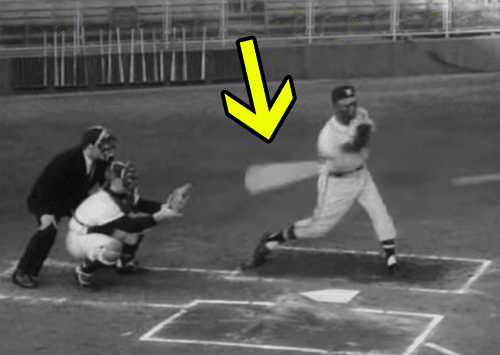

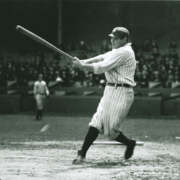
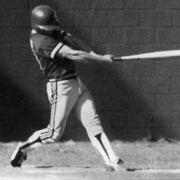

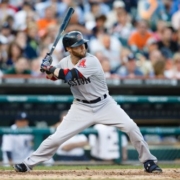

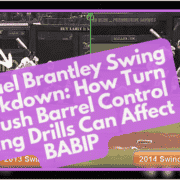



Hank Aaron is usually the first example I use when I hear coaches say a smaller player cannot hit homeruns and should hit the ball on the ground and that trying to teac them a high level swing is a waist of time (yes, i hear it all the time, wonder when coaches will start doing a little research hear in central NC) I read comments from players during his era say that Hank Aaron would sometimes wait until the ball was nearly in the carchers mitt and still hit it out of the park. I think he was just late on the pitch and his ability to get on pitch plane and early acceleration allowed him to be significantly late and still hit the ball hard. Thanks for the excellent info.
I totally agree Bobby. Looking at the smaller hitters that hit like the big ones should be where our focus goes.
Well, it is hard to criticize two of the all-time greats, especially Henry Aaron. But, here goes.
Aaron does have a significant linear component to his swing with his long stride. He also skips his back foot into contact to get his back hip into his swing, adding additional momentum.
Kaline said that Aaron just “flicked his wrists.” I don’t believe that gave him his power, which was a huge misconception in the 1960s. He did so because he found himself lunging due to his long stride, which in and of itself is not a bad thing. Though he did keep his hands back, doing that with his wrists was a way of him compensating for his foward movement. He had some down and in movement with his front shoulder on his take away but not to the extent that Ted Williams had (the subject of a previous article). This may have contributed to his being prone to lunging, since he had nothing in reserve, not conserving angular momentum.
Nevertheless, Aaron’s inability to tilt behind his rotational axis at foot plant caused his lunging and his reliance on “flicking his wrists.” He was not behind the ball to use the leverage that would be created by the stiffening of the front leg and the body getting behind his axis.
Kaline barred his front arm early in his take away and I think that this prevented him from getting on the pitch plane for lower pitches, thus the many line drives and ground balls in the contest. He said that he was not hitting the bottom half of the ball. This might have been the reason since the rigidity of the early arm bar prevented him from using a softer front elbow to aid in getting on pitch plane. He was stepping into the bucket a bit, which might have been the consequence of his early arm bar, a way of compensating for it.
However, both Aaron and Kaline were able to get on pitch plane early and stay on it. Kaline just was able to get the lift necessary to hit more home runs that day. Aaron’s lunging produced a lot of pop ups.
Joe, interesting point on Aaron not taking the front shoulder in and down towards the back hip as much as Williams…and your reasoning for him “lunging” at times, having to rely on flicking his wrist. I think Aaron and today’s Bautista have a lot in common. But I think Bautista does better at tilting his center axis of rotation. Too bad Bautista didn’t figure this “hitting thing” out sooner, because he really could have made a run at Aaron’s career homer mark.
Stop the madness!!! LOL … I’m not trying to be mean, it’s just … Geeeez guys… Have you not heard the following: You don’t hit with power by using your arms. No more than you use your arm for powering the ball in pitching. Of course, you CAN hit with your arms — but why would you?
It is just physics…
The way out of this quagmire is to lay down all the baggage — all the preconceived notions that people have from the moment they pick up their first bat, and swing it with their arms.
George, I agree. There’s a study I’ll share in a future post that measured – using muscle activation sensors – muscles firing off during the swing of professional and MLB players. In short, there was little to no muscle activation in the forearm muscles during the whole swing. The triceps where the only “arm” muscles to have any significant spike.
I have always considered Hank Aaron as an anomaly. He was such a great athlete that he could get away with his over active wrists and still square up many, many pitches. But I believe he was truly one of a kind and I stay away from his videos as much as possible in my teaching.
Good point Jon 🙂
Jon, if you look at Aaron and EVERY GREAT Hitter, you will see all the same things. I wouldn’t “stay away from his videos” in your teaching. Athletes use their WHOLE bodies and there is coordinated movement that starts from the ground up. Teaching Hitting went to sh*t in the 1990s and early 2000s because of steroids.
Joey,
Look at Aaron’s upper body and head position. He drifts forward with his stride and by the strict definition of lunging, he’s doing it. He keeps his hands back enough to still hit. If when his front foot planted/heel dropped he went back with his upper body behind his axis, he wouldn’t have lunged so much. On most of his swings in this clip, he was on his axis. On some, he is over/in front of his axis.
Joe, you’re correct in your observations of Aaron. There’s good lunging and bad. Bad is when the front knee fails to straighten. Good is an aggressive forward movement towards the ball to build linear momentum, followed by a “blocking” of the front leg to transfer linear into angular momentum. On the latter version of lunging, whether the axis tilts forward or back will depend on being on time with the pitch. We teach tilting the axis back towards the catcher, but need to allow for natural compensations to pitch type, speed, and location.
George and Joey,
No one is advocating hitting with your arms, at least not me. I am just commenting on what Al Kaline commented on as far as Aaron’s swing goes, which can be seen in the HR Derby clip.
How’d you like to be that pitcher lobbing the ball in 60 feet away with no screen??
The power they generate really speaks to how valuable weight transfer can be, to me. I see a lot of youth hitters “sit and spin” or stay back too much. Their rotation is good, their hands are good (bat path) etc. but the generate no power. Many (most?) hitting instructors hate long strides or even leg kicks. One of my players kicks his leg like Matt Holliday, you should hear the gripes I get from others.
I firmly believe pitching approaches have changed over time. Even in this era, many pitchers still stayed up in the zone and tried to overpower hitters. Sweeping swings (early on plane, but at a lost of rotational quickness) worked. Jackie Robinson’s swing was the ultimate sweep. Can you find any video of him hitting a low an outside pitch?
Today is different. Pitchers stay down and away most of the time and change speeds more often. So we have to be quicker rotationally resulting in the swings we see today.
I do think we can learn the power of weight transfer from this video, specifically getting off that back leg/foot and incorporate this concept into our teachings.
I agree Jeff! And I was thinking the same thing with the pitcher throwing BP fastballs without a screen to HANK AARON! lol 😀 What’s funny is, I think the change in today’s pitching to down AND away, is to an efficient hitter’s advantage. Like Perry Husband said in his reaction time research, the majority of high ball exit speeds and home-runs were on low pitches! A hitter has more time to react to those pitches, AND in Hank Aaron’s case, build more “steam.”
Jeff,
That’s why they invented pitching screens.
The key is to incorporate both linear and angular momentum and not one as opposed to the other. Linear momentum in the stride and angular momentum once the front foot/heel plants. Then, adding some forward movement with the ba into and through contactck foot skipping forward.
Both Aaron and Kaline lost some angular momentum in their swings (at least the ones shown in the HR Derby clip) with arm barring, I think, Kaline in his take away prior to his turn and Aaron during his final turn, to use Joey’s term.
I agree Joe, linear and angular need to be used together and not one more than the other. Here’s the thing Joe – with early arm barring in a home-run derby…to me it’s okay. In this situation, the hitter knows the pitch type, speed, and for the most part, pitch location. Early arm bar can be justified here to maximize batted ball distance. “Bat speed” in a home-run derby isn’t as important, like it is in a game situation. Also, I agree about Kaline early arm bar, but I didn’t see Aaron doing that on ALL home-runs or swings. He still kept a slight bend in the front arm prior to the Final Turn.
Sorry, that is the back foot skipping.
Pre launch torque and inertia in the bat. Not as much as Oh, but that’s no random bat wiggle “noise” you see him and Griffey and Bonds doing. hmm they’re all related. It’s falling forward plus gaining lag angle and it’s coming off tilt forward – rearward down behind him dorsally. It’s the also the counterbalance for the first move. He’s Supinating and pulling the handle opposite the front hand. The fulcrum is between his hands at that point, not at the bottom of the bat.
He didn’t get down linerally on all of them the same, but when he got down, buddy he got down. He drives his hips and body forward like a pitcher, and he’s making enough force and leverage to knock a small full size home refrigerator over with his lead pocket at 1/2 stride = 1ft. He gets his force vector (trailing foot to knee) moving horizontally in a hurry,with torsion in the knee and leg, closes the lead edge of the pelvis (probably with trailing hip internal rotation). That’s the key to his quickness, the first move and why he could wait so long. He has more read time. Acceleration is the power component, his trailing knee is rigid so he’s not using a lot of muscle there but controls his balance Sweetspot to rapidly accelerate.
You put those 2 things together, prelaunch bat inertia a top that first move, and you have a perfect storm for early batspeed. Add the 2nd foot of fomo to engage the elastic components and you have what all those players were talking about, rocket off bat. Acellerating or Terminal speed by impact, Levered-up in half the amount of time = power.
Wrists are involuntary with all that behind them but what he did do well is freeze his hand apex and head (pretty well) so his wrists are the only thing you can pick out at 32 fps.
Lunging, yeah a little as far as freezing his head everything time. But I’ll take it over anything AK was doing.
AK looked like he was hitting oppo. Back foot moves forward but ends up dorsally instead of toward the plate. The turning hip binds And never get the full turn into impact, and the result is the upper body falling out dorsally head falling out and a vicious rollover.
You shouldn’t try pull the ball over the fence with your back foot behind you dorsally or stacked behind you.
It also looks like he was inputing late rotational signal with his trailing hip,Iike a late bug squish.
Aaron in contrast gets completely off the backside, and all the concentric pelvis rotation input comes from the front side, and latent rotational input from the rear comes from the trailing X leg of the fascia from the 2 ft stride plus the momentum of the back leg being connected etc comes crashing in toward the plate and ball like wrecking ball.
Good convergence of the trailing elbow with the wrecking ball before impact, advancing and levered-up trailing fulcrum.
I imagine they had to pay Kaline $1000 just to get him in the ring with Aaron.
I also imagine they were both cold, but you could take Aaron through a proper warm up, and get him in sync and he’d done better with the lunging and hit more ding dongs, but AK could have warmed up and not much would’ve changed with those trailing mechanics dragging down the fulcrum.
I like a long stride as far as timing and absorbing the pitcher for making contact, and the power it creates when you can develop the balance and proprioception to control it. I showed my son this video and he said. “he bats like me”. He’s 12.
On the faster pitchers, we initiate forward motion sooner, and we stride further than we do the slower pitchers, because if he has gas, he’s got just as much offspeed, so we need to cover a wider spectrum, bat needs to be on plane longer, easiest way to do that is stride further and give yourself more opportunity to bump into it and put yourself closer to the off speed.
A good pitcher throws closer to the batter which affects timing because batter has less feet to judge how fast it’s going or what it is.
it’s been my experience with my athletes that although the math says the closing speed is increased by the batter moving closer to the pitcher on a fast ball, that it helps you equally as well on the offspeed to be closer to the pitcher which in essence takes away his timing advantage. We also experienced much less “blow by” when we open the stride length up so the math doesn’t really hold up vs our game observations.
Aaron looked like he could cover both ends of the spectrum pretty good with his swing. Offensive threat works good for me.
Good one on the no L- screen comment, that was insane, but he made more than AK did!
Joey,
Elastic energy created in the takeaway, prior to the final turn. I meant that Aaron loses someting by barring his arm in his final turn, which is still angular momentum prior to conact. Also, how much does a hitter change his swing for a HR Derby? Today maybe they do, but not those guys 50 years ago.
Blake,
Two questions:
“Pre launch torque and inertia in the bat. Not as much as Oh, but that’s no random bat wiggle “noise” you see him and Griffey and Bonds doing. hmm they’re all related. It’s falling forward plus gaining lag angle and it’s coming off tilt forward – rearward down behind him dorsally.”
(1) Do you believe that a hitter should hold his bat still, perpendicular to the ground, prior to initiating his stride?
“AK looked like he was hitting oppo. Back foot moves forward but ends up dorsally instead of toward the plate. The turning hip binds And never get the full turn into impact, and the result is the upper body falling out dorsally head falling out and a vicious rollover.”
(2) Do you believe that the back foot should skip towards the plate (I think that Ted Williams did that) or forward toward’s the pitcher?
Joe
Just looked at Kaline on my laptop rather than on my phone. Chechnya out his grip at 3:14. His hands are separated! Aaron said that Kaline had “a sweeping swing.” This was because of his grip – the bat is in the middle of his top hand. Can’t tell if his hands are still separated at contact.
Sorry, this phone has its own vocabulary . Too funny. It’s check out his grip.
I don’t think it’s good to hold the bat still and perpendicular to the ground. Doing so makes the bat heavy and encourages it to flip late and very out front into the zone.
Hands back like even with or just outside the arm pit, bat-on-hat is a good place to start.
Aaron had 3 inputs of inertia 1) the tick-tock inertia 2) increasing lag angle inertia tilting it toward the Pitcher 3) it was taking a ride on his fomo. He made it light and easy to flip.
The back foot should skip toward the plate and forward. When the trailing hip turns the foot should be inside the plant foot toward the plate. How much is a function of pelvis width We do a drill called the Frank Thomas drill on a tee, where we chase the bat with the trailing knee maintaining a front side angle-zero pike. There’s quite a bit of tension built up and just learning to release it into the contact is a challenge at first. It actually winds up being the first step toward first base all for free when you learn to control it. The drill is to insure you have no resistance preventing pelvis rotation going into contact. It will save you a second or 2 getting to first.
Spreading the hands is a Ty Cobb thing. It’s a way to increase torque on the handle. Really allows you to “wind” the bat as you swing. We use it all the time especially when we use a longer bat or a heavier bat. My my son got to full counts last season, instead of choking up, he’d leave the bottom hand on the bottom, but raise and seperate his top hand 1-3″. Doing so would make it easier to control contact especially up high. And you offset a small loss in batspeed with more leverage at contact. Instead of pulling with a 3″ lever with the lead side into the fulcrum (top hand) you wind up pulling with a 5-6″ lever when you spread the hands.
I had a 6’3″ senior 2 seasons ago that swung at 33″ his last 3 seasons. I made him switch to a 34″ his senior season but he couldn’t control it and the head would dip. So I made him spread his hands only so that his top hand pinky could reach diagonally down the handle to touch his bottom hand. He hit .526 with 6 bombs that season and never looked back. Works when you’re late, tired, fatigued, use at the beginning of hitting until you get warm, and on target and slowly slide the top hand down as you go until you reach stacked.
Go back and watch the last Oh video Joe posted. Look how far his bat moves on his tick tock (which is more on plane than Aaron’s). Then sequence that rotational inertia into his first move/fall. that’s a 2 stage centrifugal effect. Perfect storm for early batspeed and much mojo at impact with his pull back.
Aaron’s tick tock is somewhat perpendicular or has higher degree of seperation until it achieves the proper plane (without some torque input from upper body). But like I say, it’s the counterbalance for the first move and Aaron “drives” his body forward, that may be what is required to balance out the degree of his move.
Oh uses gravity and posturing for his first move and it isn’t nearly as aggressive as Aaron’s drive.
Oh’s tick-tock angle is much closer the swing plane. He is smooth! And just drops the hammer like he’s giving a spanking-up into that ass! Excellent pre- acellerated pendulum effect, even dispite the front side balance pull-off thing he had going..
It looked like the pitchers helped him out throwing low and low/in low/out. It would be interesting to see how his approached worked up in the zone in and away.
Blake,
What do you mean by tick-tock?
So, no stationary bat in stance for you. Do you remember Dick Allen and Darryl Strawberry’s swing?
Great comments guys…Joe, I think Blake is referring to the “tick-tock” as the “waggle” Hank Aaron does with his bat before the Final Turn. Correct me if I’m wrong Blake, but he (Blake) is saying this movement helps to counterbalance his aggressive move forward. Because of Blake, I’m actually re-living the fomo with some of my seasoned hitters. We worked on it early in their journey, but put it away for awhile. It’s effects are truly magical when getting a hitter into natural movements.
Thanks! Yes the tick tock would be the waggle. It’s not random or let’s say it shouldn’t be if you’re going to use it. We actually don’t use the waggle, but we do use Pre-launch torque. The question in the post on Oh and Aaron was what are they doing to make repeatable power?
The waggle/tick-tock and using prelaunch torque to pull and put the bat on plane early is something they’re both doing. They are a little different but when they do it in the sequence is very similar.
Blake,
Sorry to ask so many questions – by prelaunch torque, do you mean the pulling forward on the knob of the bat with the bottom hand while the top hand is pulling down?
Joe
Hi Joe, as far as Pre-launch torque I mean using your forward pulling force as an anchor, and prelaunching the bat head rearward in a circular path with the top hand using a combination of supination in wrist/forearm, and shoulder adduction. The supination is first and very subtle, then the adduction pics up as you guide the elbow into the “slot” as it converges with the trailing pelvis to form the backside fulcrum of the hand apex.
When you watch the Oh video, his Pre-launch torque comes off the fullest forward tilted point on his waggle or tick tock. The rearward rotation of the bat head prior to front foot landing.
It’s like getting a head start on the rotation. Pre-launch position rotation. It’s controlled momentum of the bathead to get it moving in the direction of the unknown plane that it’s traveling toward.
I hope that answers your question Joe.
And yes Joe, the bottom hand is anchoring the knob. At the point in the counter-rotation move of the upper body during the fall, the bottom hand hasn’t started pulling on the knob. That’s why I say it’s anchoring.
Joey…. I was checking on some of my old comments just to see how far I’ve come… I know a few things… I always knew what I felt and at times just didn’t know how to communicate it until I started following you… You told me to gather my thoughts, read Thomas Myers and do my own experiments…The few things I know are if I took a bat and just swong it using someone’s cue I can tell from FEEL if it was a good cue or not…And than I would have to think about the cue in a sense of absolutes which is a communication thing…but that’s my experiment and I know it doesn’t seem like sound science but believe me I had the swing and feel is most important… My problem was I had many injuries ( knee and hand operations and further pretty bad ankle and shoulders) and my posture was horrible… Funny I thought I had below average posture and now I can tell you I was so fucked up with regards to posture I’m still shocked that not a single Doctor advised me on it…. But many wanted to cut me…. At the end… After 7 months of correcting my posture I really understand my body really well and now my posture is really good… I can breath so easy and now I stand using my muscles as opposed to leaning on my bones or other nonsense…I’ve said it before the shit I learned fixing my posture ( still on going) is so amazing that I wouldn’t even discuss it as it’s truly mind blowing and difficult to even believe…
All I can say is when I was a kid these are things I always thought off, felt or NOTICED were important when I was hitting… Notice that at this point I had a really good swing…
To start it was easy and I wondered why others can’t do it…. It was like slow motion, I never had to rush, I never though off any cue, My major points of focus were to get my feet and hands right and than just focus on what I wanted to do, I was always thinking of where to go not how to do it, in my mind I just had to touch the ball with my left side (active) and compress the ball ( via a punch), I noticed after I compressed the ball I just went through it and finished in a neat pose so that happened when I did it right, I was (was — meaning I didn’t think about it but noticed it) very grounded, I had a few points of tension where I felt I was like I was pushing onto a wall pushing back), I pulled a few strings, I got strong and than free fall, I adjusted when needed with anything ( yes anything meaning my stride, freefall, my hands, my rear armpit) ( it appears that once you know the system adjusting is automatic depending on where the batter was during the time the batter noticed that an adjustment was needed, meaning you can feel where you are in the sequence and work the adjustment in)… I squeezed my hands (notice the hands have multiple points) as hard as I wanted ( I could do this because I know how it all worked which by the way is a GREAT TEST for the batter as to his/her understanding of the swing system), the balls I hit carried and were heavy to fielders, I tried my best to wait until I faced the ball ( important)…. I aways hit across my chest…I always hit hard…. At a younger age I gripped the bat and did a little movement to get into my stance… Within a year I just gripped the bat and just got into my stance…. It felt the same without the “little movement”… And all I did was see ball and hit ball and made sure it all felt right… Even on adjustments all I did was make the feeling right… So the adjustments came from a plurality of places but made it feel right…
So where am I going with this… Well I’m not going into the details as its to hard to discuss but it’s in the hands and feet with the feel…. Obviously more to it than that but it has to start there…You get that right than all you do is get strong and scan the ball… SCAN…. Noticed the caps… You do scan than release… Said another way… You see ball ( scan) than hit ball (release )… And I’m very confident I can actually prove it….
I read these comments and all I have to say is I would really try to get what Aaron is doing and not from a perspective of he could have done this better or that better… I would start with if this is the swing why is he doing every single thing… Meaning there’s good reasons for all of it… Also remember THE SWING comes from one but the orientation may differ… So again the comment isn’t he could do this better or that better but why is he doing this or that….
By the way all those the arms can’t do this or he flicks his hands which is not good or the body or core does this or the power comes from the ground… STOP IT….Just stop it… Just think about it if it were that easy than everbofy would know it…. It’s fucking complicated… Its not what or where the power comes from its how to get as much power as possible from point a to point b….With most things that are complicated… It’s not the big things but the little things that are most important….And everything we see outside just happens…
What I see in Aaron… He sets up (feel), gets strong(feels), scans the ball and sloftly touches it… And the bat does its thing…And I bet it feels like he’s in slow motion… You can’t scan and touch the ball if you dont do the first two right… Later…
And please comment when you have time… Hope all is well…
~DM